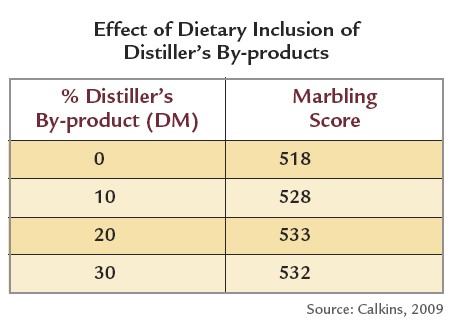
Enough, but not too much
Research shows a beef quality benefit to modest use of distillers grain byproducts
by Miranda Reiman
A decade ago, distillers grains were not common feedstuffs. Today they’re routinely included in cattle finishing diets, at levels that can boost beef quality grades.
Chris Calkins, University of Nebraska meat scientist, says when “wet distillers grains plus solubles” (WDGS) are fed at moderate levels, marbling scores increase.
“It tends to be a quadratic effect. If you do not feed any distillers grains, you get a given level of marbling,” he says. “As [WDGS] in the diet increases, we see an increase in marbling score up until about 30% to 40%; beyond that the benefits to marbling tend to disappear.”
At national animal science meetings last summer, Calkins presented a meta-analysis of studies that looked at WDGS feed effects. Larry Corah and Mark McCully of Certified Angus Beef LCC (CAB) cited that presentation in a recent research review of factors responsible for a spike in beef quality grades. Through July 2009, 60.1% of cattle in the nation’s harvest mix were grading USDA Choice, a 7.5-percentage-point leap in just two years.
An abrupt departure from the 30-year decline in grades, the recent turnaround may be partly explained by judicious use of WDGS.
“Marbling increases, but if you get the levels too high it starts to trail off,” Calkins says. The data he presented showed a marbling score of 518 for animals fed no WDGS. The score increased 14 to 15 points, up to 533, for animals fed WDGS at 20% to 30% on a dry-matter (DM) basis.
“That seems to support earlier findings that at inclusions above that 30% to 40%, distillers can actually hurt quality grade,” says Corah. “Fortunately a large majority of feedlots are using the byproducts at a fairly low rate.”
A 2007 survey estimated most feedlots used WDGS at 16.5% of diets, but that has likely jumped in recent years due to availability.
Calkins says the marbling score increase is probably related to fat content of the feedstuffs.
“When you make ethanol from corn you’ve basically driven off about two-thirds of the components,” he says, noting that both ethanol and CO2 are produced from the starch that comprises two-thirds of corn grain. “So everything else is concentrated by about three-fold. That includes the fat content.”

This higher-fat diet promotes marbling development. Theoretically, it can increase external fat as well, but Calkins says that’s a fairly small shift.
“I don’t think there’s a big worry for producers in terms of cutability issues with using wet distillers grains,” he says.
WDGS also seems to increase DM intake, especially in starter rations. One Nebraska study shows nearly a 30% increase.
“It’s a highly effective feedstuff in terms of increasing average daily gain and dry matter intake,” Calkins says.
From a meat quality standpoint, the only drawback to feeding WDGS seems to be the increase in polyunsaturated fats. They can cause discoloration and off-flavor more quickly than other fats when exposed to oxygen.
“That’s dose-dependent,” he notes. “In other words, the more distillers we feed, the bigger issue it can become.” Feeding WDGS at 20% to 30% should pose fewer challenges for retail beef than those higher percentages. However, at any level the problems can be easily managed by supplementing diets with vitamin E, Calkins adds.
Although the WDGS effect on marbling score seems slight, Corah estimates it accounts for around 5 percentage points of the grade increase. That’s based on applying the shift to packing data, where many cattle grades sit on the line between Choice and Select or low- and premium Choice.
“That’s going to increase the proportion of cattle that could conceivably qualify for the Certified Angus Beef ® brand,” Calkins says. “When you draw a specific line in marbling, that 15-point shift can be pretty meaningful.”
To read “Quality Grade: What is driving the recent upswing?” in its entirety, visit www.cabcattle.com/about/research.
